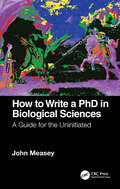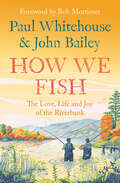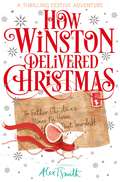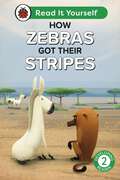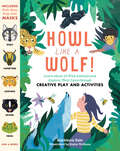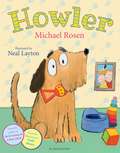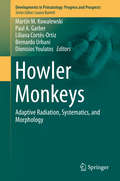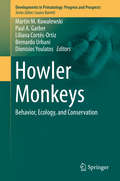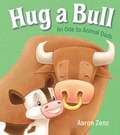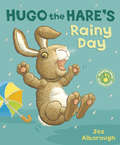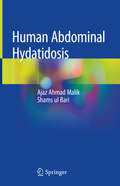- Table View
- List View
How to Walk on Water and Climb up Walls: Animal Movement and the Robots of the Future
by David HuDiscovering the secrets of animal movement and what they can teach usInsects walk on water, snakes slither, and fish swim. Animals move with astounding grace, speed, and versatility: how do they do it, and what can we learn from them? In How to Walk on Water and Climb up Walls, David Hu takes readers on an accessible, wondrous journey into the world of animal motion. From basement labs at MIT to the rain forests of Panama, Hu shows how animals have adapted and evolved to traverse their environments, taking advantage of physical laws with results that are startling and ingenious. In turn, the latest discoveries about animal mechanics are inspiring scientists to invent robots and devices that move with similar elegance and efficiency.Hu follows scientists as they investigate a multitude of animal movements, from the undulations of sandfish and the way that dogs shake off water in fractions of a second to the seemingly crash-resistant characteristics of insect flight. Not limiting his exploration to individual organisms, Hu describes the ways animals enact swarm intelligence, such as when army ants cooperate and link their bodies to create bridges that span ravines. He also looks at what scientists learn from nature’s unexpected feats—such as snakes that fly, mosquitoes that survive rainstorms, and dead fish that swim upstream. As researchers better understand such issues as energy, flexibility, and water repellency in animal movement, they are applying this knowledge to the development of cutting-edge technology.Integrating biology, engineering, physics, and robotics, How to Walk on Water and Climb up Walls demystifies the remarkable mechanics behind animal locomotion.
How to Walk on Water and Climb up Walls: Animal Movement and the Robots of the Future
by David HuDiscovering the secrets of animal movement and what they can teach usInsects walk on water, snakes slither, and fish swim. Animals move with astounding grace, speed, and versatility: how do they do it, and what can we learn from them? In How to Walk on Water and Climb up Walls, David Hu takes readers on an accessible, wondrous journey into the world of animal motion. From basement labs at MIT to the rain forests of Panama, Hu shows how animals have adapted and evolved to traverse their environments, taking advantage of physical laws with results that are startling and ingenious. In turn, the latest discoveries about animal mechanics are inspiring scientists to invent robots and devices that move with similar elegance and efficiency.Hu follows scientists as they investigate a multitude of animal movements, from the undulations of sandfish and the way that dogs shake off water in fractions of a second to the seemingly crash-resistant characteristics of insect flight. Not limiting his exploration to individual organisms, Hu describes the ways animals enact swarm intelligence, such as when army ants cooperate and link their bodies to create bridges that span ravines. He also looks at what scientists learn from nature’s unexpected feats—such as snakes that fly, mosquitoes that survive rainstorms, and dead fish that swim upstream. As researchers better understand such issues as energy, flexibility, and water repellency in animal movement, they are applying this knowledge to the development of cutting-edge technology.Integrating biology, engineering, physics, and robotics, How to Walk on Water and Climb up Walls demystifies the remarkable mechanics behind animal locomotion.
How to Walk on Water and Climb up Walls: Animal Movement and the Robots of the Future
by David HuDiscovering the secrets of animal movement and what they can teach usInsects walk on water, snakes slither, and fish swim. Animals move with astounding grace, speed, and versatility: how do they do it, and what can we learn from them? In How to Walk on Water and Climb up Walls, David Hu takes readers on an accessible, wondrous journey into the world of animal motion. From basement labs at MIT to the rain forests of Panama, Hu shows how animals have adapted and evolved to traverse their environments, taking advantage of physical laws with results that are startling and ingenious. In turn, the latest discoveries about animal mechanics are inspiring scientists to invent robots and devices that move with similar elegance and efficiency.Hu follows scientists as they investigate a multitude of animal movements, from the undulations of sandfish and the way that dogs shake off water in fractions of a second to the seemingly crash-resistant characteristics of insect flight. Not limiting his exploration to individual organisms, Hu describes the ways animals enact swarm intelligence, such as when army ants cooperate and link their bodies to create bridges that span ravines. He also looks at what scientists learn from nature’s unexpected feats—such as snakes that fly, mosquitoes that survive rainstorms, and dead fish that swim upstream. As researchers better understand such issues as energy, flexibility, and water repellency in animal movement, they are applying this knowledge to the development of cutting-edge technology.Integrating biology, engineering, physics, and robotics, How to Walk on Water and Climb up Walls demystifies the remarkable mechanics behind animal locomotion.
How to Walk on Water and Climb up Walls: Animal Movement and the Robots of the Future
by David HuDiscovering the secrets of animal movement and what they can teach usInsects walk on water, snakes slither, and fish swim. Animals move with astounding grace, speed, and versatility: how do they do it, and what can we learn from them? In How to Walk on Water and Climb up Walls, David Hu takes readers on an accessible, wondrous journey into the world of animal motion. From basement labs at MIT to the rain forests of Panama, Hu shows how animals have adapted and evolved to traverse their environments, taking advantage of physical laws with results that are startling and ingenious. In turn, the latest discoveries about animal mechanics are inspiring scientists to invent robots and devices that move with similar elegance and efficiency.Hu follows scientists as they investigate a multitude of animal movements, from the undulations of sandfish and the way that dogs shake off water in fractions of a second to the seemingly crash-resistant characteristics of insect flight. Not limiting his exploration to individual organisms, Hu describes the ways animals enact swarm intelligence, such as when army ants cooperate and link their bodies to create bridges that span ravines. He also looks at what scientists learn from nature’s unexpected feats—such as snakes that fly, mosquitoes that survive rainstorms, and dead fish that swim upstream. As researchers better understand such issues as energy, flexibility, and water repellency in animal movement, they are applying this knowledge to the development of cutting-edge technology.Integrating biology, engineering, physics, and robotics, How to Walk on Water and Climb up Walls demystifies the remarkable mechanics behind animal locomotion.
How to Write a PhD in Biological Sciences: A Guide for the Uninitiated
by John MeaseyYou don’t have to be a genius to write a PhD. Of course, it will always involve a lot of hard work and dedication, but the process of writing is a whole lot easier if you understand the basic ground rules. This book is a guide through the dos and don’ts of writing a PhD. It will be your companion from the point when you decide to do a PhD, providing practical guidance to getting started, all the way through the nuts and bolts of the writing and editing process. It will also help you to get - and stay - in the right mental framework and establish good habits from the beginning, putting you in a commanding position later on. Examples are tailored to the biological sciences, offering a unique reference for PhD students in these disciplines. Embarking on a PhD doesn’t need to be daunting, even if it’s your first experience working within academia. Each short section focuses on writing - considered by many to be the most difficult aspect of a PhD - and delves into a practical detail of one aspect, from the title to the supplementary material. Whether you’re a student just starting your studies, an early career researcher or a supervisor struggling to cope, the book provides the insider information you need to get ahead.
How to Write a PhD in Biological Sciences: A Guide for the Uninitiated
by John MeaseyYou don’t have to be a genius to write a PhD. Of course, it will always involve a lot of hard work and dedication, but the process of writing is a whole lot easier if you understand the basic ground rules. This book is a guide through the dos and don’ts of writing a PhD. It will be your companion from the point when you decide to do a PhD, providing practical guidance to getting started, all the way through the nuts and bolts of the writing and editing process. It will also help you to get - and stay - in the right mental framework and establish good habits from the beginning, putting you in a commanding position later on. Examples are tailored to the biological sciences, offering a unique reference for PhD students in these disciplines. Embarking on a PhD doesn’t need to be daunting, even if it’s your first experience working within academia. Each short section focuses on writing - considered by many to be the most difficult aspect of a PhD - and delves into a practical detail of one aspect, from the title to the supplementary material. Whether you’re a student just starting your studies, an early career researcher or a supervisor struggling to cope, the book provides the insider information you need to get ahead.
How We Do It: The Evolution and Future of Human Reproduction
by Robert MartinDespite our seemingly endless fascination with sex and parenting, the origins of our reproductive lives remain a mystery. Why are a quarter of a billion sperm cells needed to fertilize one egg? Are women really fertile for only a few days each month? How long should women breast-feed? In How We Do It, primatologist Robert Martin draws on forty years of research to locate the origins of everything from sex cells to baby care-and to reveal what's really "natural” when it comes to making and raising babies. He acknowledges that although it's not realistic to reproduce like our ancestors did, there are surprising consequences to behavior we take for granted, such as bottle feeding, cesarean sections, and in vitro fertilization. How We Do It shows that once we understand our evolutionary past, we can consider what worked, what didn't, and what it all means for the future of our species.
How We Fish: The new book from the fishing brains behind the hit TV series GONE FISHING, with a Foreword by Bob Mortimer
by null Paul Whitehouse null John BaileyPaul Whitehouse and fishing expert John Bailey celebrate the timeless joy of fishing. Paul Whitehouse and John Bailey have been devout fishermen for longer than they care to remember. A hobby, past time or sport – call it what you want – they have felt the pull of the water ever since they were kids and have never missed the chance to set up on the bank and try their luck. In this wonderful book, the two fishermen collaborate to celebrate the rich tapestry that is fishing – from mentors to memories; from philosophy to modern jargon; from watercraft to becoming self-styled ‘Fishing Detectives’. Punctuated by brilliant stories, beautiful illustrations by Carys Reilly-Whitehouse, and recollections from fishing day trips past, How We Fish is the perfect tome for the veteran fisherman or the budding angler – warm, funny and rich in the wonders of the riverbank.
How Winston Came Home for Christmas
by Alex T. SmithJoin Winston the mouse as he sets out on another irresistible Christmas adventure!From Alex T. Smith, bestselling author of the Claude series, comes How Winston Came Home for Christmas – the festive sequel to the much-loved How Winston Delivered Christmas. Full of gorgeous colour artwork and Christmassy activities for all the family to enjoy, this second Winston adventure is sure to become a Christmas classic to be enjoyed year after year.It is five days until Christmas and Winston has a Very Curious Mystery to solve. He has hazy rememberings of another mouse, and he just knows that someone very important to him is lost. After promising Oliver that he will be back in time for Christmas, no matter what, Winston sets out on an exciting round-the-world adventure to find the missing mouse, helped along the way by wonderful old friends and delightful new ones, too.A Christmas mystery written in 24-and-a-half-chapters, one to read every day of December in the lead up to Christmas, each chapter includes it's very own festive activity for all the family to enjoy together – including crafting decorations, making Christmas food, discovering Christmas traditions from around the world and so much more!
How Winston Came Home for Christmas: A Festive Illustrated Chapter Book! (How Winston Delivered Christmas)
by Alex T. SmithJoin Winston the mouse as he sets out on another irresistible Christmas adventure!From Alex T. Smith, bestselling author of festive favourites How Winston Delivered Christmas, The Grumpus and The Nutcracker, comes the chapter book edition of How Winston Came Home for Christmas – the festive sequel to the much-loved How Winston Delivered Christmas. Filled with gorgeous black and white illustrations, this is the perfect Christmas gift for children who are ready to start reading by themselves.It is five days until Christmas and Winston has a Very Curious Mystery to solve. Recently, he has been having hazy memories of another mouse, and he just knows that someone very important to him is lost. After promising Oliver that he will be back in time for Christmas, no matter what, Winston sets out on an exciting round-the-world adventure to find the missing mouse, helped along the way by wonderful old friends and delightful new ones, too.How Winston Came Home for Christmas is a heartwarming illustrated story by Alex T. Smith, bestselling author of the Claude and Astrid and the Space Cadets series for younger readers.This ebook has been optimized for tablets and smart devices to best display the stunning illustrations. This means changing the size and format of the text is not possible. For the best experience, please download a sample to your device before purchase.
How Winston Delivered Christmas: A Festive Chapter Book with Black and White Illustrations
by Alex T. SmithJoin a brave little mouse on a big Christmas adventure! This is the chapter book edition of Alex T. Smith's modern Christmas classic How Winston Delivered Christmas, with gorgeous black and white illustrations from the author throughout – the perfect festive gift for newly confident readers.Winston is on a Very Important Mission. On Christmas Eve, he finds a letter to Father Christmas that did not make it to the post box – so, with no time to lose, he sets out to deliver it himself in time for Christmas Day! He has a lot of Very Exciting Adventures on his Very Important Mission and makes some wonderful friends along the way. Will he find Father Christmas in time?How Winston Delivered Christmas is a heartwarming illustrated story by Alex T. Smith, bestselling author of the Claude series.
How Winston Delivered Christmas: A Christmas Story in Twenty-Four-and-a-Half Chapters
by Alex T. SmithFrom Alex T. Smith, bestselling author of the Claude series, comes How Winston Delivered Christmas – the irresistible story of the brave little mouse who sets out on an adventure on Christmas Eve. Featuring beautiful colour artwork and Christmassy activities to make-and-do throughout, this gorgeous book is sure to become a festive family tradition that will be enjoyed year after year.Winston the mouse is on a Very Important Mission. On Christmas Eve, he finds a letter to Father Christmas that did not make it to the post box – so, with no time to lose, he sets out to deliver it himself in time for Christmas Day! He has a lot of Very Exciting Adventures on his Very Important Mission and makes some wonderful friends along the way. Written in twenty-four-and-a-half chapters, one to enjoy each day in the lead up to christmas, each chapter includes it's very own festive activity for all the family to enjoy together – including writing a letter to Father Christmas, making mince pies, designing your very own Christmas cards, making presents, creating decorations, and so much more! This flapped paperback features a festively foiled cover and artwork on beautiful paper, making it the perfect Christmas gift. And don't miss Winston's next daring adventure, How Winston Came Home for Christmas.
How Zebras Got Their Stripes: Read It Yourself - Level 2 Developing Reader (Read It Yourself)
by LadybirdBased on the classic West African folktale about bravery. Why are zebras stripy, and why do baboons have red bottoms? Find out what happens when a bossy baboon and a plucky little zebra go head-to-head, with long-lasting consequences.How Zebras Got Their Stripes is from Developing Reader Level 2 and is ideal for readers aged from 5+ who can read short, simple sentences with help.Each book has been carefully checked by educational and subject consultants and includes comprehension puzzles, book band information, and tips for helping children with their reading.With five levels to take children from first phonics to fluent reading and a wide range of different stories and topics for every interest, Read It Yourself helps children build their confidence and begin reading for pleasure.
Howl like a Wolf!: Learn about 13 Wild Animals and Explore Their Lives through Creative Play and Activities
by Kathleen YaleNow in paperback, the acclaimed Howl Like a Wolf! fosters creative play and fun learning by inviting kids to act out the habits and behaviors of 13 animals--from balancing an egg like a emperor penguin to stalking like a camouflaged leopard--using the accompanying pop-out masks.
Howler
by Michael Rosen Neal LaytonHumans can be so confusing, especially when you're a dog. I live with a family of humans, you see. A big, man-human, a big lady-human and a little girl-human. Well, one day the lady-human's tummy started getting bigger and bigger. Then - and you won't believe this - suddenly her tummy got smaller, but there was another human living with us! And the big humans won't let me anywhere near it! Honestly, I don't know what all the fuss is about . . . A massively entertaining story perfect for anyone awaiting the arrival of a new baby. Michael Rosen, author of We're Going on a Bear Hunt, is on top form in this brilliant picture book. 'Fresh and entertaining, and ultimately enlightening' Scottish Sunday HeraldBrilliantly read by Michael Rosen. Please note that audio is not supported by all devices, please consult your user manual for confirmation.
Howler Monkeys: Adaptive Radiation, Systematics, and Morphology (Developments in Primatology: Progress and Prospects)
by Martín M. Kowalewski Paul A. Garber Liliana Cortés-Ortiz Bernardo Urbani Dionisios YoulatosHowler monkeys (genus Alouatta) comprise 12 species of leaf-eating New World monkeys that range from southern Mexico through northern Argentina. This genus is the most widespread of any New World primate and can be found to inhabit a range of forest types from undisturbed rainforest to severely anthropogenically-impacted forest fragments. Although there have been many studies on individual species of howler monkeys, this book is the first comprehensive volume that places information on howler behavior and biology within a theoretical framework of ecological and social adaptability. This is the first of two companion volumes devoted to the genus Alouatta.This volume:· Provides new and original empirical and theoretical research on howler monkeys· Presents evolutionary and adaptive explanations for the ecological success of howler monkeys· Examines howler behavior and ecology within a comparative frameworkThese goals are achieved in a collection of chapters written by a distinguished group of scientists on the evolutionary history, paleontology, taxonomy, genetics, morphology, physiology, and anatomy of howlers. The volume also contains chapters on howlers as vectors of infectious diseases, ethnoprimatology, and conservation.
Howler Monkeys: Behavior, Ecology, and Conservation (Developments in Primatology: Progress and Prospects)
by Martín M. Kowalewski Paul A. Garber Liliana Cortés-Ortiz Bernardo Urbani Dionisios YoulatosHowler monkeys (genus Alouatta) comprise twelve species of leaf-eating New World monkeys that range from southern Mexico through northern Argentina. This genus is the most widespread of any New World primate taxa, and can be found to inhabit a range of forest types from undisturbed rainforest to severely anthropogenically impacted forest fragments. Although there have been many studies on individual species of howler monkeys, this book is the first comprehensive volume to place information on howler behavior and biology within a theoretical framework of ecological and social adaptability. This is the second of two volumes devoted to the genus Alouatta.This volume:· Examines behavioral and physiological mechanisms that enable howler monkeys to exploit highly disturbed and fragmented habitats· Presents models of howler monkey diet, social organization, and mating systems that can also inform researchers studying Old World colobines, apes, and other tropical mammalsThese goals are achieved in a collection of chapters written by a distinguished group of scientists on the feeding ecology, behavior, mating strategies, and management and conservation of howlers. This book also contains chapters on the howler microbiome, the concept of behavioral variability, sexual selection, and the role of primates in forest regeneration.
Hox Modules in Evolution and Development (Evolutionary Cell Biology)
by David E. K. FerrierFew, if any, genes have had the same level of impact on the field of evolutionary-developmental biology (evo-devo) as the Hox genes. These genes are renowned for their roles in patterning the body plans and development of the animal kingdom. This is complemented by the distinctive organisation of these genes in the genome, with them frequently being found as clusters in which gene position is linked to when and where the individual genes are expressed, particularly during embryogenesis. This book provides the latest overviews of Hox gene organisation and function for major clades of animals from across the animal kingdom. With the rapidly increasing availability of high-quality whole genome sequences from an ever-expanding range of species, it is becoming increasingly evident that there is great diversity in the organisation of Hox genes. These great strides in genome sequencing are wedded to important developments in our ability to detect expression and disrupt gene function in species that are not traditionally genetically-amenable animals. These technical developments are integrated with wide taxon-sampling in this volume to provide new perspectives on the roles of Hox genes in understanding fundamental issues such as embryo patterning, mechanisms of gene regulation, homology, evolvability, evolutionary novelties, phylogeny, the role of gene and genome duplications in evolution, and ancestral states for major clades of animals. Key features Integrative overviews from major animal groups including, arthropods, vertebrates, echinoderms, mollusks and other spiralians. Perspectives gleaned from the latest genome sequence and gene expression data. Individual chapters written by world-leading experts in Hox genes and evo-devo in each animal group. Related Titles Scholtz, G., ed. Evolutionary Developmental Biology of Crustacea (ISBN 978-9-0580-9637-1) Mattick, J. & P. Amaral. RNA, The Epicenter of Genetic Information (ISBN 978-0-3675-6778-1) Bard, J. Evolution: The Origins and Mechanisms of Diversity (ISBN 978-0-3673-5701-6)
Hox Modules in Evolution and Development (Evolutionary Cell Biology)
by Ferrier, David E. K.Few, if any, genes have had the same level of impact on the field of evolutionary-developmental biology (evo-devo) as the Hox genes. These genes are renowned for their roles in patterning the body plans and development of the animal kingdom. This is complemented by the distinctive organisation of these genes in the genome, with them frequently being found as clusters in which gene position is linked to when and where the individual genes are expressed, particularly during embryogenesis. This book provides the latest overviews of Hox gene organisation and function for major clades of animals from across the animal kingdom. With the rapidly increasing availability of high-quality whole genome sequences from an ever-expanding range of species, it is becoming increasingly evident that there is great diversity in the organisation of Hox genes. These great strides in genome sequencing are wedded to important developments in our ability to detect expression and disrupt gene function in species that are not traditionally genetically-amenable animals. These technical developments are integrated with wide taxon-sampling in this volume to provide new perspectives on the roles of Hox genes in understanding fundamental issues such as embryo patterning, mechanisms of gene regulation, homology, evolvability, evolutionary novelties, phylogeny, the role of gene and genome duplications in evolution, and ancestral states for major clades of animals. Key features Integrative overviews from major animal groups including, arthropods, vertebrates, echinoderms, mollusks and other spiralians. Perspectives gleaned from the latest genome sequence and gene expression data. Individual chapters written by world-leading experts in Hox genes and evo-devo in each animal group. Related Titles Scholtz, G., ed. Evolutionary Developmental Biology of Crustacea (ISBN 978-9-0580-9637-1) Mattick, J. & P. Amaral. RNA, The Epicenter of Genetic Information (ISBN 978-0-3675-6778-1) Bard, J. Evolution: The Origins and Mechanisms of Diversity (ISBN 978-0-3673-5701-6)
Huey's Tiger
by Ann CameronHow do you catch a zebra?Huey’s big brother, Julian, is mean. He says that Huey is too little and noisy to play with him. But Huey has a plan.With a few tools and a lot of skill, Huey teaches his brother a lesson – and makes a new friend along the way!
The Hug
by Eoin McLaughlinA beautiful, heartwarming picture book with all the universal appeal of Guess How Much I Love You.Hedgehog was feeling sad.As sad as a hedgehog can feel.So sad only one thing could help . . .Tortoise was feeling sad. As sad as a tortoise can feel. So sad only one thing could help . . .In this clever flipbook, both a hedgehog and a tortoise are looking for a hug. They ask all the other animals they come across but for some reason no one will hug them. Until a wise owl explains: Hedgehog is too spiky; Tortoise is too bony. And that's when they find each other!'Feels like being enveloped in your very own hug.' Kirkus'A smashing story time tale.' Books for Keeps'It's utterly lovely. It makes her face light up every time she hears it.' The Guardian Best Books of 2019
Hug a Bull: An Ode to Animal Dads
by Aaron ZenzTake a look, my dad's a Gander.Take a nap, our dads are Boars.From baby geese to kangaroos to humans, every mom and dad is known by his or her own special name. Bouncing texts full of fun wordplay and adorable illustrations feature animal parents of every shape and size, and encourage little readers to express big love. Go ahead and hug a bull!
Hug a Bull: An Ode to Animal Dads
by Aaron ZenzTake a look, my dad's a Gander.Take a nap, our dads are Boars.From baby geese to kangaroos to humans, every mom and dad is known by his or her own special name. Bouncing texts full of fun wordplay and adorable illustrations feature animal parents of every shape and size, and encourage little readers to express big love. Go ahead and hug a bull!
Hugo the Hare's Rainy Day (Nat the Cat)
by Jez AlboroughHugo the Hare HATES to get wet, and when the rain comes he huddles under his umbrella. But Hugo's friends are stuck in the rain and when Hugo comes to their rescue he can't help but get all soggy!However, perhaps having a bit of a splish splash isn't quite as bad as Hugo thinks...
Human Abdominal Hydatidosis
by Ajaz Ahmad Malik Shams Ul BariThe book explores various aspects of hydatid disease, including the background, parasitology, epidemiology, etiology, pathogenesis and presentation in humans. It features dedicated chapters on hydatidosis of liver, spleen, peritoneum, kidney, pelvis, and disseminated hydatid disease, and also provides detailed information on the latest surgical and non-surgical methods for treating the condition, such as drug therapy and laproscopic management. The book is primarily intended for undergraduate and postgraduate students of surgery and medicine, but is also useful to veterinary science students and pharmaceutical companies. Further, it serves as a valuable reference resource for academics and researchers in associated fields.

